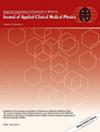Radiation dose and shielding considerations for digital dynamic radiography (DDR) compared to mobile C-arms
Abstract
Background
Digital dynamic radiography (DDR), integrated into Konica Minolta's portable mKDR system, provides dynamic imaging for pulmonary, orthopedic, and interventional applications. While DDR is not classified as fluoroscopy, its use of pulsed x-rays for cine-like image sequences raises concerns about radiation exposure and shielding, particularly given the absence of a primary beam stop, high output capabilities, and increasing clinical adoption.
Purpose
To characterize the primary and scatter radiation output of a DDR system and compare it against commonly used mobile C-arm fluoroscopy units, and to evaluate shielding requirements and potential occupational exposure risks associated with DDR use.
Methods
Radiation dose output and scatter were assessed for a Konica Minolta mKDR system and three mobile C-arms: GE OEC Elite, Siemens Cios Spin, and Ziehm Vision RFD 3D. Unshielded primary air kerma was measured at 100 cm SID using matched dose settings (low, medium, high). Scatter fraction and normalized scatter were measured at eight angles and three distances using a 20 cm PMMA phantom and an ion chamber. Additional direct comparisons of angular scatter doses between DDR and a GE C-arm were made during 20-s acquisitions at varying distances. The Klein–Nishina differential cross section was also calculated for photon energies representative of clinical settings. Leakage radiation and image receptor attenuation were quantified. Shielding requirements were estimated using NCRP 147 methodology under varying workload and occupancy conditions.
Results
DDR exhibited dose rates two to three times higher than C-arms at medium and high dose settings, with longer pulse widths (16 ms) producing greater exposure than shorter ones (5 ms). Scatter fraction peaked at 165° and increased with lower beam energy due to energy-dependent Compton interactions and reduced filtration. Compared to the GE C-arm, DDR produced consistently higher scatter values at all angular positions. Measured scatter doses at 0.3 m and 1.0 m from the phantom exceeded those from the C-arm, especially in the forward direction (0°). Image receptor attenuation measurements showed 98% beam reduction when the receptor was properly aligned. Leakage was minimal and well below FDA limits. Shielding assessments indicated that concrete thickness requirements for DDR could reach 145 mm under worst-case conditions, driven primarily by the high primary beam output rather than scatter or leakage.
Conclusions
DDR systems provide portable dynamic imaging capabilities but deliver substantially higher radiation output than conventional mobile C-arms. In addition, scatter dose rates from DDR were approximately 1.5–3 times higher than those from a conventional mobile C-arm under comparable conditions. This elevated dose, driven by high tube currents and long pulse durations, raises important safety concerns for patients, personnel, and shielding infrastructure. While DDR offers potential clinical value in motion-sensitive applications, its safe integration into practice requires careful protocol selection, attention to scatter exposure, and thoughtful shielding planning of exam rooms where the system will be used. As DDR systems become more prevalent and approach fluoroscopic performance, regulatory and design guidance may need to evolve to reflect their unique operational profile.




 求助内容:
求助内容: 应助结果提醒方式:
应助结果提醒方式:


